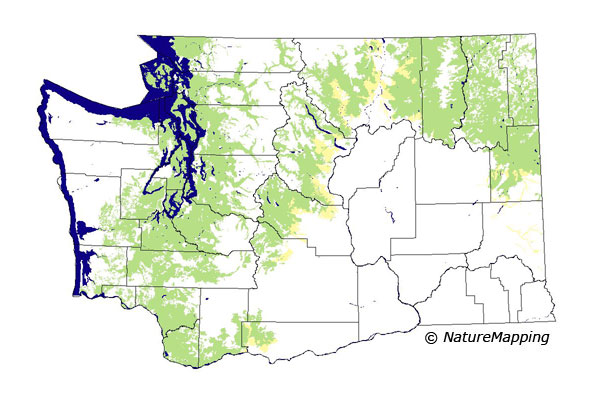 |
Metadata (Data about data or how the map was made)
Legend:
 = Core Habitat
= Core Habitat
 = Marginal Habitat
= Marginal Habitat
Predicted Distribution
Reptiles do not migrate as some birds and mammals, so the colored areas depict
the predicted range for the Northern Alligator Lizard year-round. The habitats
were identified using 1991 satellite imagery, other datasets and experts throughout
the state, as part of the Washington Gap Analysis Project.
Other
maps & Information:
|
Distribution and Habitat Requirements
Elgaria coerulea is common in the Puget Trough, especially around the Puget Sound. It is also found along the Columbia River, lower elevations
along both sides of the Cascades and in northeastern portions of the Columbia Basin. It is the only lizard found in the coastal strip of Washington.
Northern Alligator Lizards occur on the margins of coniferous forests, in clear cuts, under logs and on talus slopes. They prefer cool, moist woodlands
and are generally found at higher elevations than the Southern Alligator Lizard, E. multicarinata.
Models
All ecoregions except for the Blue Mountains were selected.
West of the Cascades, the lower elevation zones up to and including Western Hemlock were core. East of the Cascades, the Interior Douglas-fir, Grand Fir,
Interior Redcedar, Interior Western Hemlock and Western Hemlock zones were core. The Ponderosa Pine zone was core in Northeastern Washington and in the
Northeast Cascades, marginal in the East Central Cascades and excluded from the Southeast Cascades, where
Model Evaluation and Comments
Some of the records for the past two years were at elevations higher than previously known for this species in the East Cascades. Although this species is
found in Idaho, the locations in the eastern Columbia Basin probably represent isolated populations.
The apparent range limits of E. coerulea suggest it may be avoiding areas where basalt is predominant such as much of the southern Cascades. However,
as a live bearer, not dependent on a specific substrate (layer of soil), there is no obvious reason for its avoidance of basalt areas. Possibly other reptiles
benefit by the basalt substrate and their presence may exclude this species.
Translated from the Washington Gap Analysis Amphibians and Reptiles Volume by Karen Dvornich
Webpage designed by Dave Lester.